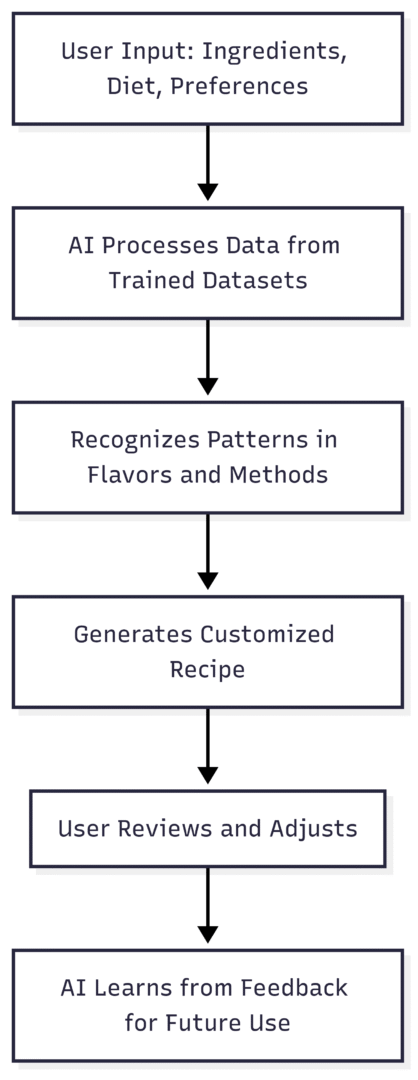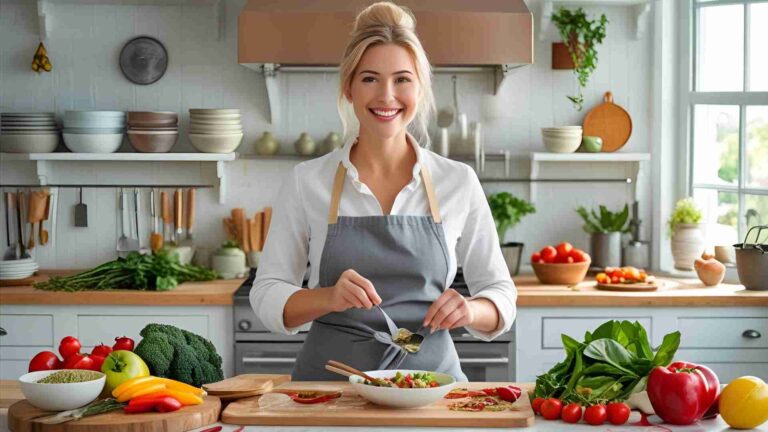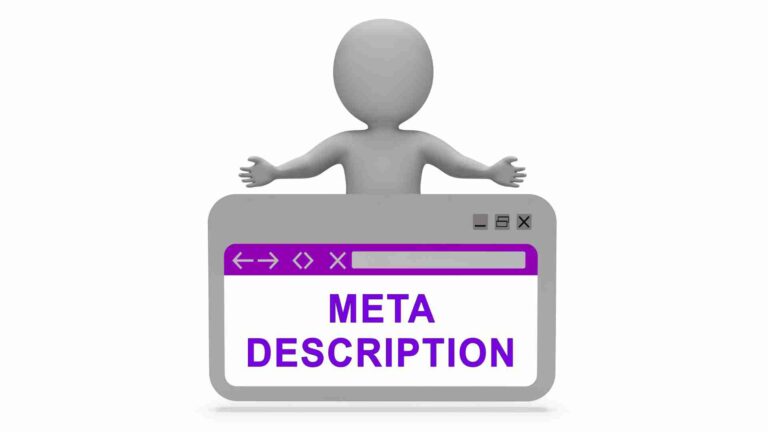Your Guide to AI-Generated Recipes
AI-generated recipes harness large language models trained on extensive culinary datasets to produce customized meal ideas. These tools analyze user inputs like available ingredients, dietary restrictions, and meal types to create novel recipes. For home cooks, bakers, and food bloggers, AI serves as a digital assistant, offering inspiration and efficiency without replacing human creativity.
Unlike traditional recipe searches, AI tools generate unique combinations by recognizing patterns in ingredient pairings, cooking methods, and nutritional profiles. This capability addresses common challenges like meal planning fatigue, food waste, and dietary constraints. A survey indicates strong interest in these tools, with many users valuing their role in daily cooking.
AI excels in scenarios where quick customization is needed. Input leftovers, and receive suggestions to minimize waste. Specify vegan or gluten-free preferences, and get tailored options. For beginners, recipes break down into simple steps, building confidence in the kitchen.
How AI Recipe Generators Work
AI recipe generators operate through a structured process powered by machine learning.
- Data Training: Models learn from vast online sources, including recipes, articles, and reviews, to understand flavor profiles, techniques, and preferences.
- User Input Processing: Users provide details such as ingredients (e.g., “chicken, basil, flour”), dietary needs (e.g., “gluten-free”), or occasions (e.g., “quick dinner”).
- Pattern Recognition and Generation: The AI predicts coherent recipes by combining learned patterns, ensuring logical steps and measurements.
- Output and Refinement: It delivers a recipe, often with options for adjustments. Feedback loops allow the tool to improve over time.
This process enables rapid creation of personalized content. For example, entering “leftover ham, cheese, egg” might yield a “Cheesy Ham and Egg Skillet” with precise instructions.

This chart illustrates the core workflow, emphasizing the iterative nature that enhances accuracy.
Benefits of AI-Generated Recipes
AI tools boost cooking efficiency and creativity in several ways.
Boosting Efficiency and Saving Time
AI eliminates the need to browse endless search results or cookbooks. Provide parameters, and receive suggestions in seconds. This is ideal for busy cooks needing quick meal ideas or substitutions based on pantry staples.
Reducing Food Waste
By inputting expiring ingredients, AI suggests recipes to use them fully. Examples include turning vegetable scraps into soup or day-old bread into pudding. This saves money and supports sustainability.
Personalization for Dietary Needs
AI accommodates restrictions like allergies, veganism, or macronutrient goals. Specify “low-carb, high-protein,” and get aligned recipes. Tools can also suggest drink pairings or scale portions for families.
Inspiration and Exploration
AI introduces new cuisines, techniques, and flavor pairings, such as chocolate with rosemary or Korean-influenced pasta. It helps diversify meals, easing into unfamiliar territories without overwhelm.
Simplifying Complex Recipes
Recipes are broken into manageable steps with clear instructions, beneficial for beginners. AI ensures uniformity in quality, making it easier to replicate results.
| Benefit | Description | Example |
|---|---|---|
| Time Savings | Instant suggestions vs. manual searching | Generate a week’s meals in minutes |
| Waste Reduction | Uses leftovers creatively | Vegetable peel broth from scraps |
| Dietary Customization | Tailors to allergies or preferences | Gluten-free pastries |
| Inspiration | New ingredient combos | Lavender-lemon desserts |
| Simplicity | Step-by-step breakdowns | Beginner-friendly baking guides |
This table summarizes key advantages, highlighting practical applications.
Top AI Tools for Generating Recipes
Several specialized tools stand out for home cooks and bakers. Here’s a selection with features, specifications, and pricing.
ChefGPT
ChefGPT creates recipes, meal plans, and pairings from pantry inputs. It supports dietary and macronutrient customization.
- Features: Unlimited generation in pro mode, multiple recipe modes.
- Pricing: Free basic plan; Pro at $2.99/month.
- Best For: Personalized nutrition tracking.
DishGen
DishGen allows real-time modifications and provides seven suggestions per ingredient list.
- Features: Dietary preference integration, recipe alterations.
- Pricing: Free basic; Premium $7.99/month; Business $15.99/month.
- Best For: Flexible cooking adjustments.
FoodAI
FoodAI focuses on global cuisines with image-based interfaces, suitable for families.
- Features: Cuisine selection, ingredient-based suggestions.
- Pricing: 30-day free trial; $0.99/month thereafter.
- Best For: Exploring international flavors.
CookAIfood
This tool enables quick recipe creation with community sharing, upvoting, and additional features like diet planners and calorie counters.
- Features: Grocery lists, printable cookbooks, nutrition monitoring.
- Pricing: Pay-as-you-go; 1 credit = 1 recipe (credit prices vary).
- Best For: Social sharing and meal planning.
Plant Jammer
Designed for waste reduction, it generates recipes from available ingredients with shopping integration.
- Features: Recipe titles, cooking times; Amazon Fresh linkage.
- Pricing: Free version (3 recipe types); Full app $10 one-time payment.
- Best For: Eco-friendly cooking.
Other Tools
- Let’s Foodie: Specializes in leftovers; free with premium options.
- KitchenAI: 24/7 advice; subscription-based.
- MealPractice: Mood-based suggestions; focuses on picky eaters.
- Recipes.lionix.io: Email-delivered recipes; user-friendly with seasonal ideas.
General AI like ChatGPT or Copilot can also generate recipes but may lack culinary-specific training, leading to errors.
| Tool | Key Features | Pricing | Best Use Case |
|---|---|---|---|
| ChefGPT | Meal plans, pairings, macros | Free; Pro $2.99/mo | Nutrition-focused |
| DishGen | Modifications, 7 options | Free; Premium $7.99/mo; Business $15.99/mo | Adaptable recipes |
| FoodAI | Cuisine exploration, images | Free trial; $0.99/mo | Family-friendly |
| CookAIfood | Sharing, planners, counters | Pay-as-you-go (per recipe) | Community engagement |
| Plant Jammer | Waste reduction, shopping | Free; Full $10 one-time | Sustainability |
This comparison table aids in selecting the right tool based on needs and budget.
How to Use AI Recipe Generators Effectively
To maximize results, follow these steps.
- Provide Detailed Inputs: Be specific—e.g., “ripe peaches, gluten-free, low-sugar dessert.” Vague prompts yield poor outcomes.
- Experiment with Pairings: Use AI as a base for creativity, like adding lavender to lemon dishes.
- Adjust and Personalize: Tweak seasonings or times; save favorites for refinement.
- Scale Recipes: For events, let AI handle portion math.
- Give Feedback: Rate outputs to train the tool for better future suggestions.
- Integrate with Tools: Sync with shopping lists, calendars, or smart appliances for seamless prep.
For bakers, AI helps scale batches or customize for allergens, but always test for texture nuances like brownie gooeyness.

This chart shows the cyclical process for optimal use.
Considerations and Cautions with AI Recipes
While powerful, AI has limitations.
Accuracy and Safety Issues
AI can “hallucinate,” producing unsafe instructions like undercooking pork. Always verify measurements, times, and combinations. Test recipes personally to avoid failures.
Spotting AI-Generated Content
Unreliable AI content floods online. Red flags include:
- Unnatural photos: Flawless textures, awkward proportions.
- Vague measurements or odd steps.
- Lack of personal engagement: No creator interaction or troubleshooting.
Real recipes from tested sources offer context, tips, and science—elements AI often strips away.
Ethical Concerns
AI trains on existing content without crediting creators, potentially harming bloggers. It favors Western recipes, limiting diversity. Over-reliance dulls intuition; use AI as a tool, not a crutch.
Testing and Humanization
For bloggers, AI inspires but requires rigorous testing. Use plugins like WP Recipe Maker to add photos, videos, and nutrition labels, ensuring credibility.
AI for Food Bloggers and Professionals
AI aids bloggers by sparking ideas from ingredients or diets. Once inspired, test and refine. WP Recipe Maker enhances blogs with templates for consistent formatting, nutrition features, and media integration.
Professionals like bakers use AI for creativity, reducing ruts. It suggests signature items but can’t replicate human subtlety. Balance AI with intuition for best results.
Integrating AI with Smart Kitchens
Advanced tools sync with appliances. AI can preheat ovens or provide hands-free guidance. This streamlines prep, especially for batch cooking or events.
For meal planning, AI generates weekly plans, shopping lists, and calendar integrations, optimizing for busy schedules.
Exploring Advanced Applications
AI enables cuisine dives, like Thai or Moroccan dishes. It minimizes waste by optimizing ingredient use and promotes healthy habits through balanced suggestions.
For dietary needs, AI personalizes deeply—e.g., PCOS-friendly plans—but double-check for biases in training data.
Conclusion: Embracing AI in Cooking
AI-generated recipes revolutionize meal creation with speed, customization, and inspiration. They reduce waste, accommodate diets, and boost efficiency, making cooking accessible. However, success depends on detailed inputs, testing, and awareness of limitations.
Combine AI’s strengths with human creativity for exceptional results. Whether a home cook or baker, these tools elevate culinary adventures—experiment wisely to craft memorable meals.
FAQs
Tools using AI to create recipes from user inputs like ingredients and preferences.
By suggesting recipes using available or leftover items.
Yes, tailoring for vegan, gluten-free, or allergen-free needs.
ChefGPT, DishGen, FoodAI, CookAIfood, Plant Jammer.
Provide specific inputs, adjust outputs, and give feedback.
Enhances creativity, reduces waste, customizes for customers.
Please share this Your Guide to AI-Generated Recipes with your friends and do a comment below about your feedback.
We will meet you on next article.
Until you can read, Top 10 Recipe Websites Without the Clutter






